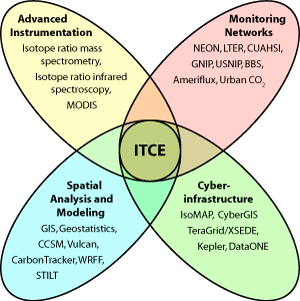
The US National Science Foundation supported a 6-year effort to develop integrated training experiences launching a generation of scientists prepared to tackle large-scale challenges associated with climatic, ecological, and biogeochemical perturbations affecting the USA and the globe. This program emphasized the use of stable isotopes in biogeochemical and ecological studies as a focal theme, but covered of a broad range of systems and techniques that are widely applicable to problems of spatial analysis, scaling, observation, and modeling of Earth system processes. The program was founded on the idea of multi-institution, collaborative, cohort-based training and education.
The period of formal NSF support for the ITCE program has ended, but many of the programs developed live on:
Multi-disciplinary summer intenstive training; cohorts of 25-30 students and 12-16 instructors drawn from the international community work together in each of two 2-week training courses; key content has been distributed via web-based instructional modules
 Extended post-course training where students will expand thesis foci at other universities and across scales through collaborative research-in-residence experiences with course instructors
Extended post-course training where students will expand thesis foci at other universities and across scales through collaborative research-in-residence experiences with course instructors
IsoMAP is a dynamic, online workspace for spatial analysis, modeling and prediction of stable isotope ratio variation in the natural environment. Visit IsoMAP to learn more or to start making isoscapes today!